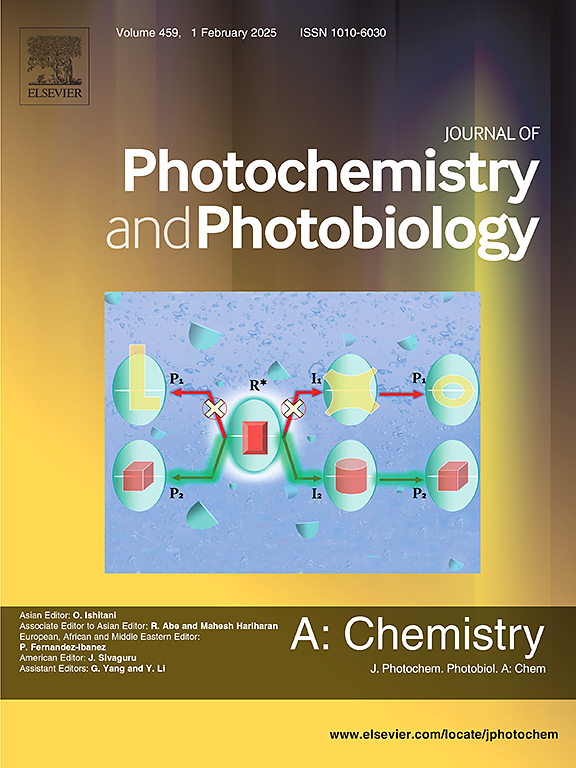Molecularly engineered tandem dye-sensitized solar cells achieving 11.02% efficiency through complementary sensitizer integration
IF 4.7
3区 化学
Q2 CHEMISTRY, PHYSICAL
Journal of Photochemistry and Photobiology A-chemistry
Pub Date : 2025-05-17
DOI:10.1016/j.jphotochem.2025.116510
引用次数: 0
Abstract
Tandem dye-sensitized solar cells (DSSCs) represent a promising avenue for advancing solar energy conversion through the molecular-level design of light-harvesting systems. In this study, we report a tandem DSSC architecture that integrates two chemically distinct sensitizers, triphenylamine-based organic dye MRSF-3 and benchmark ruthenium dye N719, selected for their complementary absorption and photophysical characteristics. The device employed a double-sided Pt electrode, with N719 in the top cell and MRSF-3 in the bottom cell, achieving a notable power conversion efficiency (ηcell) of 11.02%. Detailed electrochemical impedance spectroscopy (EIS) and Bode frequency analyses revealed enhanced charge separation, reduced recombination, and prolonged electron lifetimes compared to single-sensitizer systems, highlighting the synergy between the dyes at the molecular level. Thermogravimetric analysis (TGA) confirmed the high thermal stability of both sensitizers, supporting their potential for long-term application. This study provides molecular-level insights into light-induced charge dynamics in hybrid systems and demonstrates how rational photochemical design can optimize light absorption and electron transfer in photoactive molecular assemblies. Our findings contribute to the fundamental understanding of photochemical processes in tandem architectures and underscore their potential in efficient solar energy conversion.

分子工程串联染料敏化太阳能电池通过互补敏化剂集成达到11.02%的效率
串联染料敏化太阳能电池(DSSCs)代表了一种很有前途的途径,通过分子水平的光收集系统设计来推进太阳能转换。在这项研究中,我们报道了一种串联DSSC结构,该结构集成了两种化学上不同的敏化剂,三苯胺基有机染料MRSF-3和基准钌染料N719,选择它们的互补吸收和光物理特性。该器件采用双面Pt电极,N719在上电池,MRSF-3在下电池,功率转换效率(η电池)达到11.02%。详细的电化学阻抗谱(EIS)和波德频率分析显示,与单一敏化剂系统相比,增强了电荷分离,减少了重组,延长了电子寿命,突出了染料在分子水平上的协同作用。热重分析(TGA)证实了这两种增敏剂的高热稳定性,支持它们长期应用的潜力。这项研究提供了分子水平上对混合系统中光诱导电荷动力学的见解,并展示了合理的光化学设计如何优化光活性分子组件中的光吸收和电子转移。我们的发现有助于对串联结构光化学过程的基本理解,并强调了它们在高效太阳能转换方面的潜力。
本文章由计算机程序翻译,如有差异,请以英文原文为准。
求助全文
约1分钟内获得全文
求助全文
来源期刊
CiteScore
7.90
自引率
7.00%
发文量
580
审稿时长
48 days
期刊介绍:
JPPA publishes the results of fundamental studies on all aspects of chemical phenomena induced by interactions between light and molecules/matter of all kinds.
All systems capable of being described at the molecular or integrated multimolecular level are appropriate for the journal. This includes all molecular chemical species as well as biomolecular, supramolecular, polymer and other macromolecular systems, as well as solid state photochemistry. In addition, the journal publishes studies of semiconductor and other photoactive organic and inorganic materials, photocatalysis (organic, inorganic, supramolecular and superconductor).
The scope includes condensed and gas phase photochemistry, as well as synchrotron radiation chemistry. A broad range of processes and techniques in photochemistry are covered such as light induced energy, electron and proton transfer; nonlinear photochemical behavior; mechanistic investigation of photochemical reactions and identification of the products of photochemical reactions; quantum yield determinations and measurements of rate constants for primary and secondary photochemical processes; steady-state and time-resolved emission, ultrafast spectroscopic methods, single molecule spectroscopy, time resolved X-ray diffraction, luminescence microscopy, and scattering spectroscopy applied to photochemistry. Papers in emerging and applied areas such as luminescent sensors, electroluminescence, solar energy conversion, atmospheric photochemistry, environmental remediation, and related photocatalytic chemistry are also welcome.

 求助内容:
求助内容: 应助结果提醒方式:
应助结果提醒方式:


